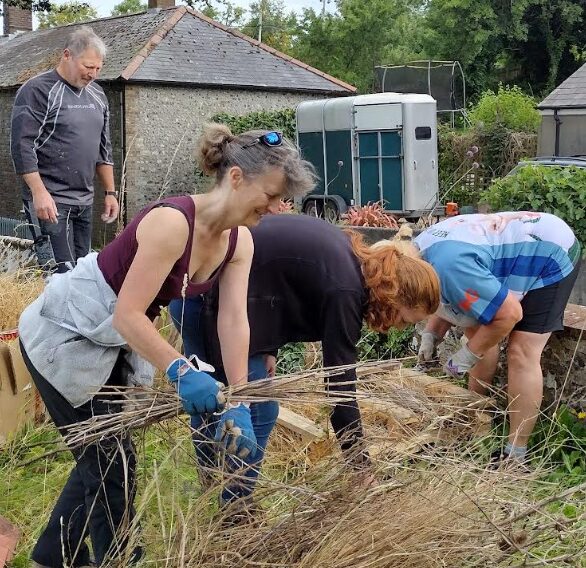Small, consistent habits and a supportive community beat unrealistic resolutions for health and wellbeing every time, says expert Karen Geary

At the end of last year, I joined a challenge at my local gym. The run-up to the festive season can be stressful, as we all know, and the aim was to provide some collaborative support. ‘Buddy benefits’ or ‘buddy systems’ have been widely researched – and it has been clearly demonstrated that working with others can make a material difference to weight and fitness goals. I didn’t know these women before I started, but the inspiration, encouragement and camaraderie from the group (we used an online app) were incredible.
Halfway through, I suddenly found myself dealing with some serious family health stress and was unable to do everything I had set myself originally (more on that in a moment), but the team kept me going, with things I was able to do when I could. I soon learned how small things done consistently can make massive differences, rather than aiming for lofty goals – and failing.
Which brings us to the New Year.
The media world is once again full of the ‘new year, new you’ messages which make me instantly rebel against the very idea of it. Besides, it’s mid-winter, and the body does not wish to be put under undue pressure. This time of year is all about nourishment and self-care.
Small things add up
But there are a number of small things that, done consistently, will really have an impact on your health. Let’s start with staying hydrated.
One of the things I committed to during the challenge was taking in enough water: my rule-of-thumb calculator was 35ml per kg of body weight, and when I tracked it I was honestly shocked to find I wasn’t drinking enough. Staying hydrated was a game-changer: my skin, health, weight, energy and sleep all improved. I was also less hungry. It’s a boring tip, I know, but – are you sure you’re drinking enough?
Next – we don’t need to eat all the time! The UK has a strong snacking culture, but our bodies are not meant to snack. Unless you have a medical condition or are an athlete with very demanding goals, a steady three meals a day is more than enough for most people.
Creating consistency with three meals a day and not eating on the run is something most of us can do. I couldn’t always manage it when I was dashing back and forth to the hospital, but I stuck to it when I could, thanks to the team support.
Protein and fibre with every meal. Protein and fibre create satiety (feeling ‘full’) – if you have these covered, it’s so much easier not to snack and to stick to your plans.
Here’s a quick starter for ten to get you thinking along the right lines:
Breakfast Ideas:
- High-Protein Omelette
2 eggs + 2 egg whites
Spinach, tomatoes and a sprinkle of feta cheese
Serve with a slice of wholegrain toast - Vegan Overnight Oats:
50g rolled oats soaked in plant milk
1 tbsp chia seeds, 1 scoop plant-based protein powder and a handful of berries
Topped with crushed nuts for fibre - Greek Yogurt Bowl:
200g Greek yogurt
1 tbs flaxseeds, a handful of mixed berries or stewed apple (skin on) and 1 tsp honey (optional)
Sprinkle with a small handful of oats, sugar-free granola or nuts
Lunch Ideas - Chicken and Bean Salad:
Grilled chicken breast on a bed of mixed greens
Add chickpeas, cherry tomatoes, cucumber and ½ avocado
Drizzle with olive oil and lemon - Vegan Lentil and Quinoa Bowl:
100g cooked quinoa mixed with 150g cooked lentils
Add roasted vegetables like courgette, peppers and carrots
Top with a tahini dressing - Salmon and Broccoli Stir-Fry:
1 salmon fillet stir-fried with broccoli, edamame and mixed peppers
Served with brown rice - Home made vegetable soup is always good
Remember to add some protein. Try chicken, egg, prawns, tofu or beans
Dinner Ideas - Chicken/turkey and Sweet Potato Tray Bake:
Lean chicken or turkey breast, roasted with sweet potatoes, Brussels sprouts and red onion
Season with herbs, olive oil and garlic - Vegan Chickpea Curry:
Chickpeas, tomatoes, spinach, onion, garlic and coconut milk simmered with turmeric, chilli powder and cumin
Served with cauliflower rice - Fish & Mixed Vegetable Bake:
Baked fish fillet on a bed of asparagus, cherry tomatoes and green beans
Drizzle with lemon juice and olive oil

Walking
I missed quite a few gym sessions, but I walked around the hospital quite a lot, got outside for some fresh air when it wasn’t raining, and always used the stairs. Walking doesn’t always get the recognition it deserves, but it’s a powerful tool for both physical and mental health.
Be kind to yourself
When setting your New Year goals, be kind to yourself. Start with small, sustainable habits and remember that consistency is key. Best of all, try and find a ‘buddy’ so you can cheer each other on. What small change will you focus on this January? Share it with a friend or your own ‘buddy’ to make it stick!
My thanks to the ladies at Lukins Fitness and especially to Rachel Howard for creating such an incredible group.
























